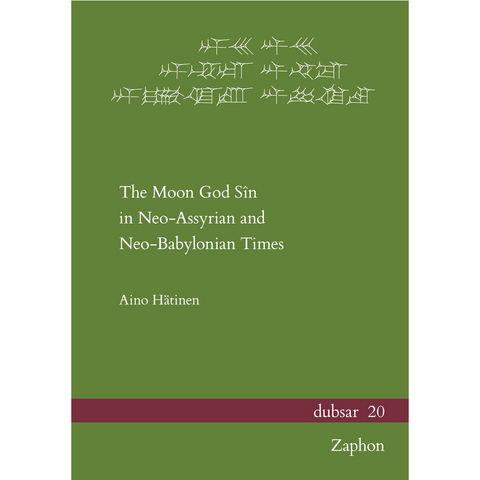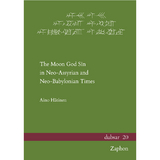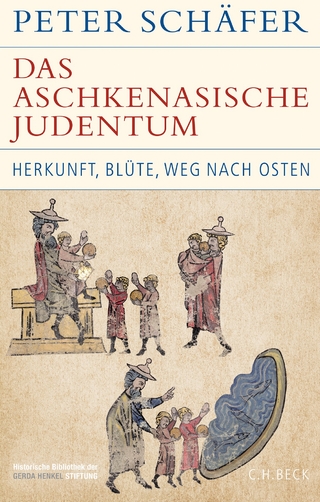The Moon God Sîn in Neo-Assyrian and Neo-Babylonian Times
Seiten
Der Mondgott Nanna/Sîn ist eine der Hauptgottheiten im sumero-babylonischen Pantheon und mithin seit den Anfängen der Assyriologie von herausragender Bedeutung. Neben die allgegenwärtige Präsenz von Sîn in Keilschriftquellen und der Mondsichel in der mesopotamischen Kunst tritt seine Rolle im Kontext der Himmelswahrnehmung: Die Mondzeichen dominieren die Sphäre der Himmelswahrnehmung im 1. Jahrtausend v. Chr. Die sargonidischen Könige von Assyrien offenbarten ein starkes Interesse am Mondgott von Ḫarran im 8.–7. Jahrhundert v. Chr., gefolgt von der Verehrung Sîns durch den babylonischen König Nabonid im 6. Jahrhundert v. Chr. Die theologischen Konzepte rund um Sîn beschränken sich keineswegs nur auf seine Rolle als Gott des Mondes. Er teilte vielmehr je nach Kontext zahlreiche Fähigkeiten und Kräfte mit anderen Gottheiten des mesopotamischen Pantheons. Die Quellen aus neuassyrischer und neubabylonischer Zeit beschreiben den Mondgott Sîn in erster Linie als den Mond, einen Himmelskörper, der die kosmische Ordnung verkörpert und die Zeit regelt, Botschaften über die von ihm oder anderen Gottheiten getroffenen Entscheidungen übermittelt, Stabilität bringt für die Herrschaft des Königs, Menschen (und Tiere) sich fortpflanzen lässt – und sie aber auch mit Epilepsie und Hautkrankheiten befällt (von denen er sie wieder heilt, wenn er will). Er ist nicht nur in Kultbildern in und um Heiligtümer präsent, sondern auch am Nachthimmel, wo er sich Tag für Tag, Monat für Monat unaufhörlich manifestiert; das Juwel des Himmels, umgeben von jubelnden Sternen.
Die vorliegende Studie setzt sich aus zwei Hauptteilen zusammen: „Theologies of the Moon God in Assyria and Babylonia“, welcher ihn charakterisiert und in sein familiäres Umfeld einbettet, und „The Cult of Sîn in Babylonia and Assyria“, welcher seine Rolle in seinen Kultorten und Tempeln erörtert; diese werden ergänzt durch Editionen ausgewählter Texte und umfangreiche Register. The moon god Nanna/Sîn is one of the primary deities in the Sumero-Babylonian pantheon, and, for this reason, has been of interest since the early days of Assyriological research. In addition to the ubiquitous presence of Sîn in cuneiform sources, and the crescent moon in Mesopotamian art, scholarly interest in him can be attributed to his prominent role in the context of celestial divination: the lunar omens dominate the sphere of celestial divination in the 1st millennium BCE. Also, the marked interest of the Sargonid kings of Assyria in the Ḫarranian moon god in the 8th–7th centuries BCE and the veneration of Sîn by Nabonidus in the 6th century BCE have received much attention from various scholars. The theological concepts surrounding Sîn are by no means limited only to his role as the god of the moon, but he shared numerous abilities and powers with other deities of the Mesopotamian pantheon depending on the context. The sources from the Neo-Assyrian and Neo-Babylonian periods describe the moon god Sîn first and foremost as the moon, a celestial luminary that embodies cosmic order and regulates time, conveys messages about the decisions he or other deities have made, brings stability to the reign of the king, allows people (and animals) to procreate, and afflicts them with epilepsy and skin diseases (but also heals them, if he wills). He is present not only in cult images in and around sanctuaries but also in the night sky, where he unceasingly makes himself manifest from day to day, month to month; the jewel of heavens, surrounded by rejoicing stars.
The present study is subdivided into two main parts: “Theologies of the Moon God in Assyria and Babylonia”, characterizing himself and his family and entourage, and “The Cult of Sîn in Babylonia and Assyria” on his role in the context of his places of worship and temples. These parts are supplemented by editions of selected texts and extensive indices.
Die vorliegende Studie setzt sich aus zwei Hauptteilen zusammen: „Theologies of the Moon God in Assyria and Babylonia“, welcher ihn charakterisiert und in sein familiäres Umfeld einbettet, und „The Cult of Sîn in Babylonia and Assyria“, welcher seine Rolle in seinen Kultorten und Tempeln erörtert; diese werden ergänzt durch Editionen ausgewählter Texte und umfangreiche Register. The moon god Nanna/Sîn is one of the primary deities in the Sumero-Babylonian pantheon, and, for this reason, has been of interest since the early days of Assyriological research. In addition to the ubiquitous presence of Sîn in cuneiform sources, and the crescent moon in Mesopotamian art, scholarly interest in him can be attributed to his prominent role in the context of celestial divination: the lunar omens dominate the sphere of celestial divination in the 1st millennium BCE. Also, the marked interest of the Sargonid kings of Assyria in the Ḫarranian moon god in the 8th–7th centuries BCE and the veneration of Sîn by Nabonidus in the 6th century BCE have received much attention from various scholars. The theological concepts surrounding Sîn are by no means limited only to his role as the god of the moon, but he shared numerous abilities and powers with other deities of the Mesopotamian pantheon depending on the context. The sources from the Neo-Assyrian and Neo-Babylonian periods describe the moon god Sîn first and foremost as the moon, a celestial luminary that embodies cosmic order and regulates time, conveys messages about the decisions he or other deities have made, brings stability to the reign of the king, allows people (and animals) to procreate, and afflicts them with epilepsy and skin diseases (but also heals them, if he wills). He is present not only in cult images in and around sanctuaries but also in the night sky, where he unceasingly makes himself manifest from day to day, month to month; the jewel of heavens, surrounded by rejoicing stars.
The present study is subdivided into two main parts: “Theologies of the Moon God in Assyria and Babylonia”, characterizing himself and his family and entourage, and “The Cult of Sîn in Babylonia and Assyria” on his role in the context of his places of worship and temples. These parts are supplemented by editions of selected texts and extensive indices.
| Erscheinungsdatum | 26.01.2022 |
|---|---|
| Reihe/Serie | dubsar ; 20 |
| Verlagsort | Münster |
| Sprache | englisch |
| Maße | 170 x 240 mm |
| Gewicht | 1400 g |
| Themenwelt | Geisteswissenschaften ► Geschichte ► Regional- / Ländergeschichte |
| Geschichte ► Teilgebiete der Geschichte ► Religionsgeschichte | |
| Geisteswissenschaften ► Religion / Theologie | |
| Schlagworte | Assyrien • Babylonien • Mondgott |
| ISBN-10 | 3-96327-140-X / 396327140X |
| ISBN-13 | 978-3-96327-140-3 / 9783963271403 |
| Zustand | Neuware |
| Haben Sie eine Frage zum Produkt? |
Mehr entdecken
aus dem Bereich
aus dem Bereich
Von den Anfängen bis zur Gegenwart
Buch | Hardcover (2022)
C.H.Beck (Verlag)
34,00 €
Herkunft, Blüte, Weg nach Osten
Buch | Hardcover (2024)
C.H.Beck (Verlag)
39,00 €
Heilsgeschichte und Weltpolitik
Buch | Hardcover (2024)
Matthes & Seitz (Verlag)
44,00 €




